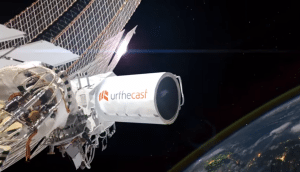[Via Satellite 08-12-2015] Vancouver-based UrtheCast has achieved Initial Operating Capability (IOC) for its High-Resolution Camera (HRC), Iris, aboard the International Space Station (ISS) in a move that will likely push the company forward on its venture to develop an interactive, publicly accessible Earth Observation (EO) platform. While UrtheCast currently operates two EO cameras aboard the ISS — Iris, its Ultra High Definition (Ultra-HD) video camera and a Medium-Resolution Camera (MRC), Theia — the company announced plans in June to develop, launch and operate the a fully-integrated, multispectral optical and Synthetic Aperture Radar (SAR) commercial constellation of EO satellites.
With the HRC camera achieving first light this quarter, the company revealed videos of London, Boston, and Barcelona that have attracted media and investor attention. As UrtheCast works over the next few months to expand capacity and lower the latency for its HRC to establish Full Operating Capability (FOC) for the technology, it is positioning itself as a new player in the EO field through acquisitions and the planned constellation.
UrtheCast plans to deploy the coming constellation, comprised of an estimated 16 satellites (eight optical and eight SAR), over multiple launches slated from 2019 and 2020. The constellation will combine with the company’s cameras aboard the ISS as well as two recently purchased EO satellites, Deimos 1 and Deimos 2, to further the company’s goal of “democratizing the view of Earth from space,” according to UrtheCast’s website.
“We’ve always felt that UrtheCast needed to expand past the International Space Station,” UrtheCast CEO Scott Larson said in an earnings call Aug. 11 for the company’s second quarter. “Deimos was the first step and this constellation will complete the process,”
UrtheCast’s acquisition of Deimos Imaging in July was for an estimated $85.3 million grafting in its two satellites and operations related to the collection, storage, processing, analysis, distribution, and licensing of imagery. While the acquisition is still new, the company reported good progress so far.
“Deimos has been operating soundly on its own with a growing revenue pipeline and we frankly don’t want to make things more complicated than they have to be,” said Larson, adding that the high and low resolution imaging Deimos 1 and Deimos 2 provide would expand their capabilities in the EO arena. “We certainly didn’t acquire Deimos to realize some operational efficiencies, as is often the case with acquisitions, but often we felt that working with Deimos we could create value from increased revenue, improve technology and operational expertise,” he said.
For the last year, UrtheCast has entered into multiple Memorandums of Understanding (MOUs) for funding, including an estimated $195 million from an undisclosed customer to support the build phase of its constellation. United Kingdom-based manufacturer Surrey Satellite Technology Limited (SSTL) is building the satellites, with manufacturing spanning from 2016 to 2020. Once launched, the satellites in the constellation will fly in two orbital planes, with each plane consisting of four satellite pairs equally spaced around the orbit.
“Each pair of satellites would consist of one dual-mode, high-resolution optical satellite, which would be capable of both video and pushbroom-type imaging as well as a dual-band high resolution SAR satellite flying in tandem,” explained Larson.
Larson expects the constellation will be able to provide optical and SAR data fusion, weather-independent high-resolution imaging using the SAR, target revisit, and low imaging-to-product delivery latency. Also, by flying the satellites in tightly formed SAR and optical tandem formations, the constellation should be able to offer on-board real-time processing, cross-queuing between the satellites, as well as real-time cloud imaging on the leading SAR satellite that enables cloud avoidance in the trailing optical satellites.
“By using two orbital planes, the constellation will allow for maximum re-visitation in the mid latitudes while providing customers with global coverage extending to the poles,” Larson said.
The company says it is in the process of engaging customers for the constellation and is in talks with “most of the customers in the world that matter, potentially,” said Larson. And while the company is looking at a financially healthy funding process so far, it will still take time to establish the backing necessary to move forward to launch.
“I would say, at a macro level, this is going to take a number of months,” said Wade Larson, president and chief operating officer at UrtheCast. “We will be engaged through 2015 to 2016 to sign more memorandums of understanding, to convert the ones that we have and to basically build out the partnerships and customer base to bring this thing to fruition.”
The post UrtheCast HRC Achieves IOC, Looks to Grow EO Presence appeared first on Via Satellite.
